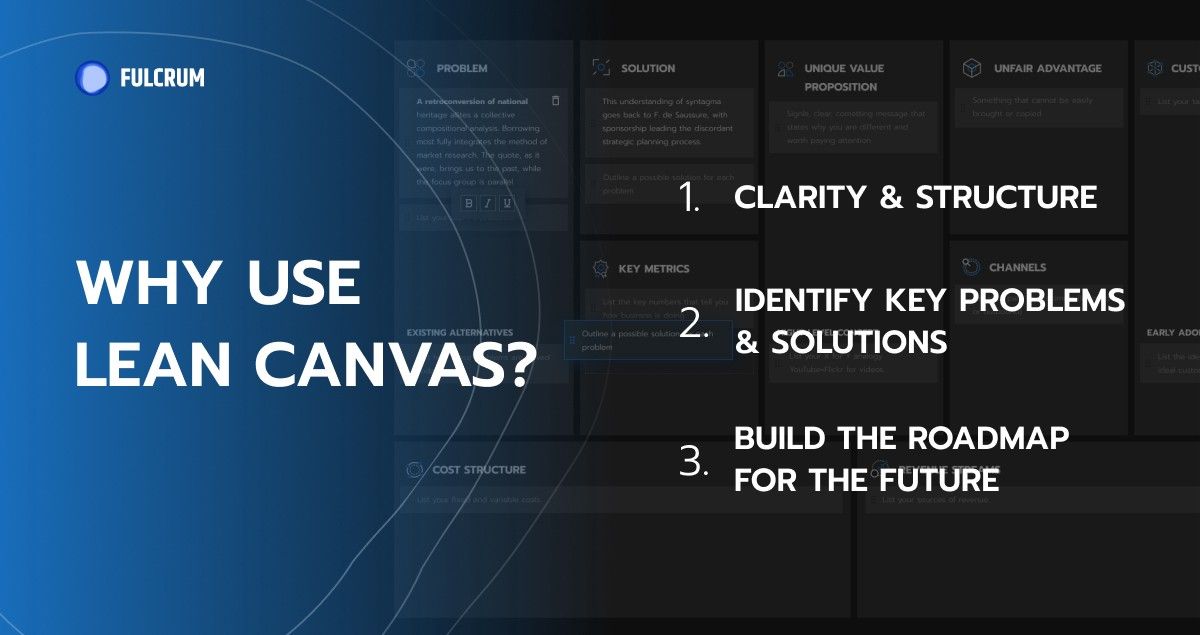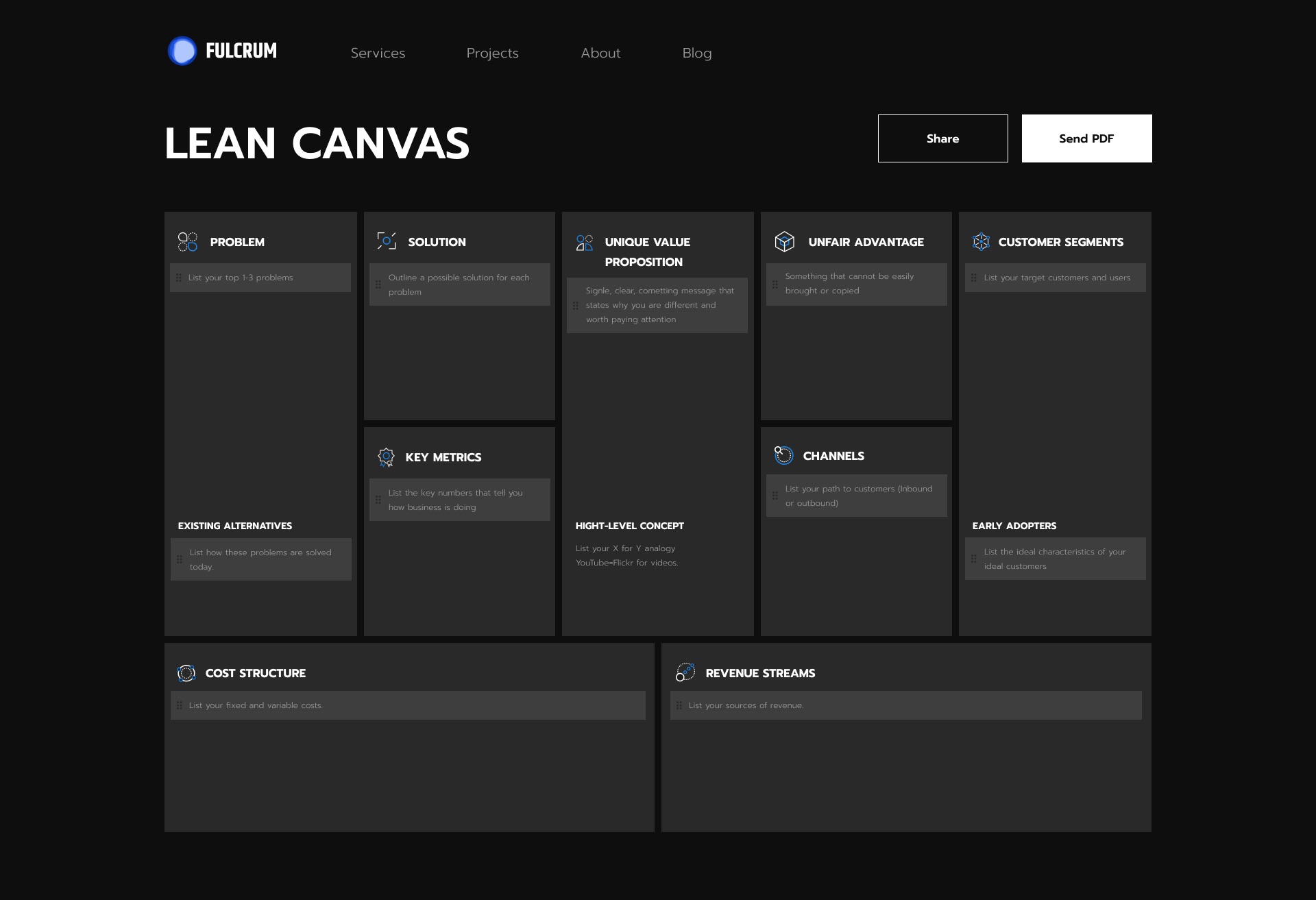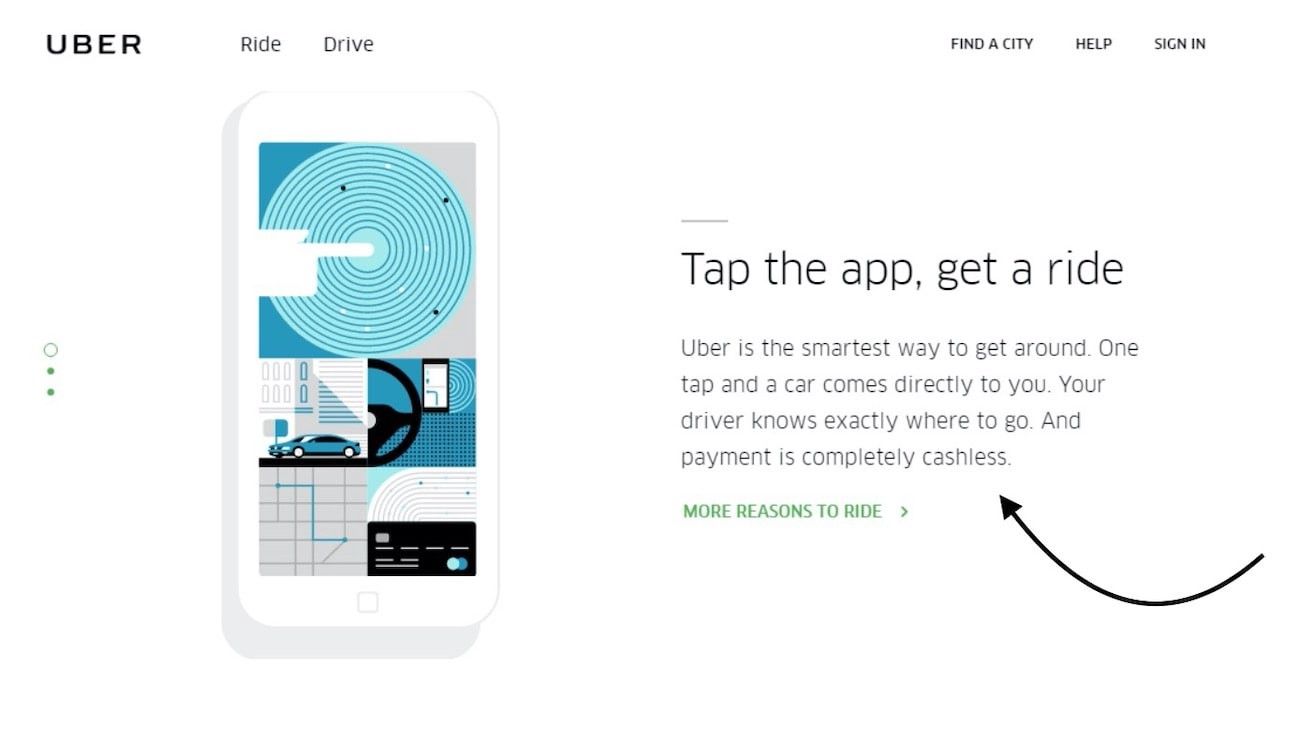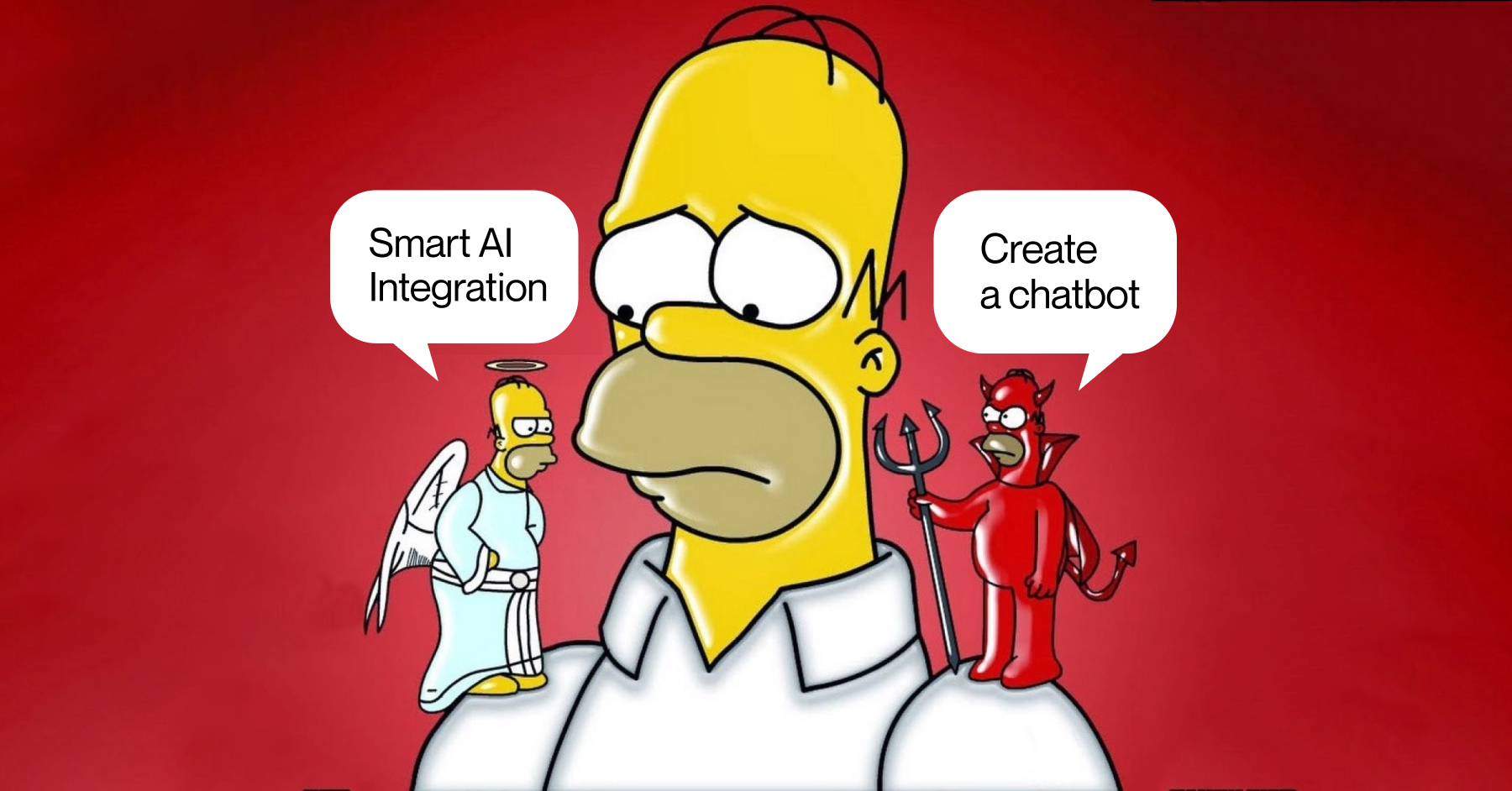When you’re a startup, you know for a fact that your idea will turn into a great product only if it is well executed. Prior to starting a project, Fulcrum team often shares Lean Canvas template with our clients. This simple but effective practice allows business owners to shape a business model for their new product execution. Then, it’s also a great starting point for successful product development.
What is Lean Canvas?
Initially, the Lean Canvas template is an adapted version of the brilliant Business Canvas model invented by entrepreneur, consultant, and expert in business modeling Alex Osterwalder. It consists of 9 blocks essential for building a business:
- Key partners
- Key activities
- Key resources
- Value propositions
- Customer relationships
- Customer segments
- Channels
- Cost Structure
- Revenue streams
This strategic management model is being used by all kinds of organizations worldwide to form a successful business blueprint. Still, to comply with the specific startup needs, it had to be slightly modified.
So, Ash Maurya created an adaptation of the Business Canvas model. Using lean methodology (built around the idea of waste elimination and resources optimization to create high-value products or services), he redesigned Osterwalder’s model into a startup-oriented Lean Canvas template.
Why Lean Canvas is Essential for Any Startup?
The number one reason why startups fail is creating a product that nobody needs. It’s called a market-fit failure. To avoid that, we advice using the Lean Canvas model to assure your product has a clear roadmap and a business plan to follow. It’s an excellent business solution that includes all fundamental key points to define before developing and launching a product.
 Get rid of possible pitfalls and discover the strong points of your future product
Get rid of possible pitfalls and discover the strong points of your future product
- Structured business model of your business and understanding of the current state of affairs.
- Identifying what is a demand for your product in a specific market niche and what problems it solves for customers.
- Your target audience defined & channels to reach your TA elaborated.

The Ultimate Guide to Fill in Lean Canvas in 20 Minutes
1. Start with the ‘Customer Segments’
Your target audience pre-defines your business model. Therefore, it makes sense to start comleting your product’s Lean Canvas model with the customer segments. Keep in mind, there’s a common stumbling block — people tend to define their audience too broadly. The golden rule states:
When you’re trying to build a product for everyone, you’ll end up selling it to noone.
If you have many different audience segments, create a separate Lean Canvas for each of them.
Let’s take Uber as an example. What is Uber’s target audience?
- Taxi drivers (as potential partners).
- City dwellers without a car.
- Tourists.
Now, try to narrow it down even more and identify your early adopters. Who is most likely to start using your app? These people have ‘above average’ needs for your product.
If we talk about Uber, we can add the geography factor here. Early adopters might be the San Francisco IT folk (San Francisco is where Uber started out). Their phone is their life. They never have cash and use credit cards, typically. They could be the most interested in ordering a taxi through the app and paying by card instead of cash.
2. Define the Problem Your Product Solves
If there’s no problem — there’s no product to solve it, simple as that. Each customer segment has distinct pains and problems. So, create a list of 1–3 pain points for each segment and be as specific as possible.
LeanStack recommends using the ‘5 -Whys technique’ invented in Toyota, which helps you to find the root of the problem. Start with a general pain point and then continue asking WHY 5 times in a row.
For instance, let’s take our client Scoob-e, an e-bike renting app in Vienna. We might start with some general statement: it’s hard to move around in Vienna. But if we continue using the ‘Why?’ technique we might get to the following problems:
- There are traffic jams if you use a car. People don’t want to stay in traffic jams.
- It’s not easy to park your car in the city center. Finding a parking spot is a nuisance.
- Public transport picks you up at certain spots, at certain times. Who wants to wait?
- Most cars aren’t eco-friendly.
In the end, you’ll get the core problems that your prospects face.
In the same section, you will see the ‘Existing Alternatives’ subcategory. Try to describe how your target audience is solving these problems at the moment. What are the alternative solutions?
Remember, you don’t describe your competitors here. This box needs to be filled with alternative ways to solve the problem. For instance, instead of using cars, people in Vienna can walk on foot or use a simple bicycle.
3. Decide on Revenue Streams
The next thing on the list is to fill in Lean Canvas with revenue streams. Why is this important? If you don’t see how you can monetize your solution then it’s not a viable business idea. So think it through before you jump into creating your MVP.
If it’s hard to determine your business model at first, start with defining the customer in your business model. Customers and target audiences aren’t always the same. For instance, in the Uber business model, taxi drivers are not the customers, yet they are also a target audience.
Next step — think through your pricing model. The pricing model is a very complicated topic itself. Do you plan on using a monthly subscription, one-time fee, or something else? Definitely document this in your Lean Canvas model.
4. Provide Solution
Take a close look at your ‘Problems’ column on the left. What is the most obvious, first-comes-to-your-head solution to the problem outlined? If you’re having doubts, sharing your Lean Canvas PDF with teammates might be a reasonable solution. What’s more, you can do a double duty, interview your stakeholders and find out their take.
5. Write down Unique Value Proposition
Lean Canvas Template has a Unique Value proposition section (also known as USP, Unique Selling Proposition). It gives you a clear understanding of who your product is for and why users should choose your company instead of your competitors.
The word ‘unique’ is here for a reason. Your value proposition needs to stand out. There are so many companies on the market, you either get noticed or go home. UVP has three components, which you can define by answering these questions:
- Who is this product for?
- What is the clear benefit?
- Why should they choose you instead of the others?
Here is an example of Uber’s UVP:

You can also use Instant Clarity Headline. It includes the end result that your customer wants, addresses the objections they have, and reveals a specific time frame.
 Make it as precise as possible to match with your ideal customer
Make it as precise as possible to match with your ideal customer
In the same field, you can add a ‘high-level concept’. It’s a quick catchphrase that describes your business best. It’s perfect to get the idea across & make sure potential investors understand your startup idea. For example, when YouTube just started out, its high-level concept was ‘Flickr for videos’.
6. Find Effective Channels
Just think about your perfect customers. Where does they consume the content so that you can offer your product at the right place and time?
While filling in your Lean Canvas model, consider all offline & online channels to reach your audience: word of mouth, offline events, social media platforms, emails, Facebook & Google ads, etc. Try to divide your channels into ‘Before purchase’, ‘During Purchase’ and ‘After Purchase’:
- Before Purchase: word of mouth, social media, CPC, PR articles, promo emails, etc.
- During Purchase: your website, catalogs, communication with sales managers, etc.
- After Purchase: email updates, customer feedback survey, social media, etc.
7. List Key Metrics
Key metrics in the Lean Canvas model is your business bottom line. These are numbers such as downloads, MQLs, SQLs, sales, and other indicators your business requires to prosper. These should be tracked on a regular basis.
But don’t stop there, always go the extra mile! Estimate your Minimum Success Criteria. It’s a breakpoint or the result your company should achieve to become successful. Think in terms of revenue: what revenue should your company have to be profitable?
8. Estimate Cost Structure
What does it take to create an ideal product? How many resources and investments are needed before it’s alive and kicking? Make sure to outline both fixed & variable costs in your Lean Canvas model.
Fixed costs are the rent, taxes, interest expenses. They are less likely to fluctuate over time in comparison to variable costs.
Variable costs are direct material costs, labor costs, marketing expenses.
Most likely, your cost structure will change over time. The good thing is — you can always come back to your lean canvas & update it.
9. Create Unfair Advantage

Your unfair advantage in Lean Canvas model for product could be something like fantastic experts on your team (which is not always the case for many companies) or cutting-edge technologies that you have.
Keep in mind that Ash Maurya warns not to list ‘first to the market’ as your Lean Canvas unfair advantage. Most profitable companies nowadays weren’t the first to the market. They were second, third, or tenth. Say Apple or Facebook. They improved and perfected technologies that were already present.
Bottom Line: Get Structured
The startup world is fast and furious…
So as the Lean Canvas model: strategic, fast, and straight to the point. Yet, to succeed in this fast-changing startup world, you always need to stay updated, structured and envision your next steps.
That is what Lean Canvas helps you with. You can see what weak and strong sides of your business idea are. Most amazing – it would take you less than 30 mins to fill it in.
To get competitive, you, first of all, need to find our what your competition is and, secondly, identify your secret weapons.

FAQ: Lean Canvas Template
-
What is a Lean Canvas?The Lean Canvas is a single-page business plan template designed for startups. It is an alternative solution to a regular lengthy business plan created by Ash Maurya.
-
What are key metrics in Lean Canvas?The key metrics in Lean Canvas depend on your business goals and KPIs. These can be downloads, conversion rates, MQLs, SQLs, sales, in-app purchases, etc.
-
What is a Lean Canvas business model?Lean Canvas business model is a visual and short business plan with 9 essential blocks that describe your business model on a single page.
-
What is a high-level concept in a Lean Canvas?The high-level concept in Lean Canvas is a one-sentence pitch characterizing your product with reference to others recognized on the market.


